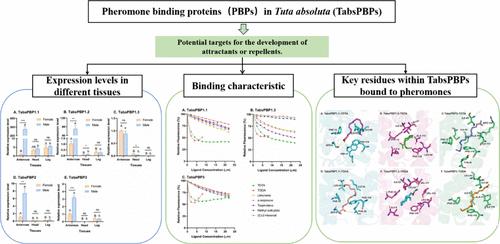Identification and Functional Disparity of Pheromone-Binding Proteins from Tomato Leafminer Tuta absoluta in Detection of Sex Pheromone Components
IF 6.2
1区 农林科学
Q1 AGRICULTURE, MULTIDISCIPLINARY
引用次数: 0
Abstract
Studies on the olfactory sensory systems of pests have substantial theoretical potential for the development of eco-friendly control strategies. Tuta absoluta (Meyrick, 1917), one of the most damaging invasive pests of Solanaceae crops, has limited research on its sex pheromone recognition mechanism. In the present study, five PBPs, including three PBP1, PBP2, and PBP3, were identified in T. absoluta. Four TabsPBPs were predominantly expressed in the antennae of male moths, of which TabsPBP1.1 had a strong and similar binding affinity to sex pheromones (3E,8Z,11Z)-tetradecatrien-1-yl acetate (TDTA) and (3E,8Z)-tetradecadien-1-yl acetate (TDDA), and TabsPBP3 had a stronger binding affinity to TDDA than the primary sex pheromone component TDTA. TabsPBP1.3 did not show a sex-biased expression pattern in the antennae, but showed binding affinity to sex pheromones and the host plant volatile terpinolen. Molecular dynamics simulations predicted the key active sites for the binding of TabsPBPs to sex pheromones. TabsPBP1.1/1.3/3 could serve as potential targets for the development of attractants or repellents.

番茄叶螨信息素结合蛋白在性信息素成分检测中的鉴定及功能差异
害虫嗅觉系统的研究对生态友好型害虫防治策略的发展具有重要的理论潜力。绝对图塔(Tuta absoluta, Meyrick, 1917)是茄科作物中危害最大的入侵害虫之一,对其性信息素识别机制的研究比较有限。本研究共鉴定出5种PBPs,包括3种PBP1、PBP2和PBP3。4种tabspbp在雄蛾触角中主要表达,其中TabsPBP1.1对性信息素(3E,8Z,11Z)-乙酸十四烯-1-酯(TDTA)和(3E,8Z)-乙酸十四烯-1-酯(TDDA)具有较强且相似的结合亲和力,TabsPBP3对TDDA的结合亲和力高于主要性信息素成分TDTA。TabsPBP1.3在触须中没有表现出性别偏倚的表达模式,但与性信息素和寄主植物挥发性萜类酚具有结合亲和力。分子动力学模拟预测了tabspbp与性信息素结合的关键活性位点。TabsPBP1.1/1.3/3可作为开发引诱剂或驱避剂的潜在靶点。
本文章由计算机程序翻译,如有差异,请以英文原文为准。
求助全文
约1分钟内获得全文
求助全文
来源期刊
CiteScore
9.90
自引率
8.20%
发文量
1375
审稿时长
2.3 months
期刊介绍:
The Journal of Agricultural and Food Chemistry publishes high-quality, cutting edge original research representing complete studies and research advances dealing with the chemistry and biochemistry of agriculture and food. The Journal also encourages papers with chemistry and/or biochemistry as a major component combined with biological/sensory/nutritional/toxicological evaluation related to agriculture and/or food.

 求助内容:
求助内容: 应助结果提醒方式:
应助结果提醒方式:


